All it takes is one look at a snapping turtle to make you wonder if dinosaurs are really extinct.
Yes, few animals are as cool as these large, lumbering, prehistoric-looking reptiles. And with a face that screams “I’ll bite your fingers off if you cross me,” there are even fewer that are as intimidating.
It’s for such reasons it would be amazing to have your own snapping turtle. But is it a good idea to keep these creatures as pets?
Unfortunately, the answer to this question isn’t a simple “yes” or “no.” These ornery reptiles can make captivating pets for people who have loads of experience handling highly challenging exotic animals. For the rest of us, however, they can be exceptionally dangerous.
To determine whether or not a snapping turtle would make a great pet for you, keep reading!
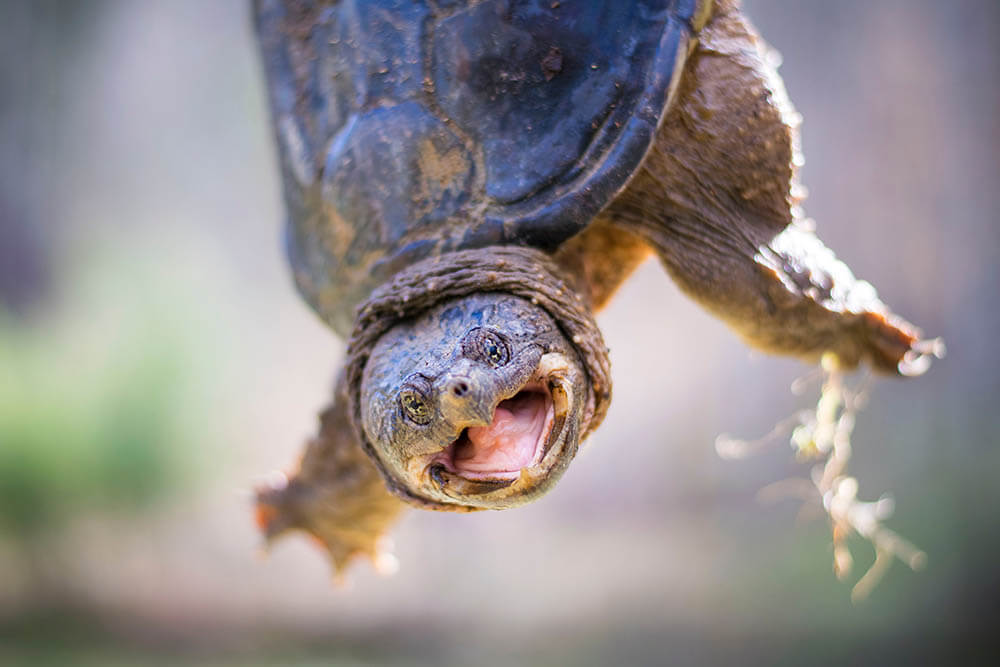
8 Things You Need to Know About Keeping Snapping Turtles as Pets
Snapping turtles can make fascinating pets for some, but terrible pets for many others. If you want one as a pet, it’s best if you’ve already owned similarly challenging pets in the past. It would also be of great benefit to request assistance and training from other experts.
In addition, do yourself a favor; familiarize yourself with the following points before acquiring your own snapping turtle:
1. They’re generally calm but can be aggressive
Snapping turtles aren’t savage monsters that go out of their way to inflict pain on others. On the contrary, when they’re in a good mood, they’re typically calm and easy to handle, while at other times they’re shy. It’s when they feel threatened or stressed that you have to be careful.
When in the water (i.e. their natural habitat), you can expect a more confident and therefore less bitey creature. On land, however, snapping turtles feel more exposed to danger as they’re both exceedingly slow and too large to fully retreat into their shell for protection. This vulnerability encourages them to behave more viciously to scare off potential predators.
In addition, snappers aren’t the most social creatures and tend to avoid creatures they can’t eat (such as humans). In the wild, they stay away from each other, with each individual occupying a part of a lake or stream separate from others’. When they do meet, they behave aggressively toward each other. Males are particularly likely to fight. The only time snapping turtles interact peacefully is when a male and female are mating.
For the above reasons, it’s important for a pet snapping turtle to feel safe as much as possible. They need to have a body of water they can relax in, while the surrounding land should be kept free of anything that it could see as a threat. As these creatures also like being left alone, you should limit your interactions with your exotic pet.
2. They can hurt you
Of the two snapping turtle species, common snapping turtles are usually the ones kept as pets.
Don’t let their status as potential pet fool you; these creatures have extremely strong bites that, when paired with their sharp beaks, can cause you a lot of pain. A fully mature common snapping turtle has a bite force of around 209 Newtons, which is powerful enough to sever your finger. While it can’t open its mouth wide enough to bite off your arm, it can certainly tear off a significant chunk of your flesh.
In fact, the common snapping turtle has a more powerful bite than the more fearsome-sounding alligator snapping turtle, which has a bite force of about 158 Newtons.
Don’t think that holding a snapper by the sides of its shell can protect you from harm; these reptiles have long, extremely flexible necks, allowing one to swing its head backward to bite you in the arm or leg. Their claws are also frighteningly sharp, though they use these not as weapons but as digging or gripping tools.
Pay attention to the sounds a snapping turtle makes. If it starts hissing, it means it feels threatened and is ready to attack you. They also release a musky scent from behind the legs when stressed.
Lastly, you can get bitten even if a snapping turtle doesn’t mean to. If you’re hand-feeding your pet, its beak can accidentally snag your hand as it lunges for the food item. Therefore, it’s ideal to suspend any food using tools such as tongs or forceps.
For all these reasons, snapping turtles are particularly dangerous to own if you share your home with children and other pets.
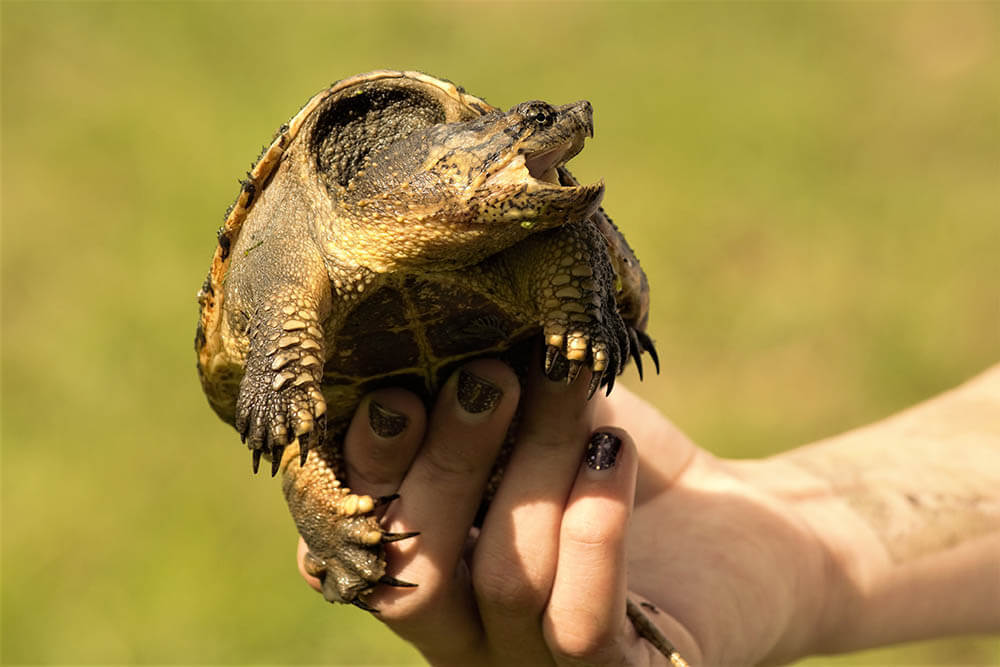
3. They can recognize you
In general, turtles have great long-term memories about things that are important to their survival. It’s for this reason snapping turtles can recognize their owners.
If you’re the person who feeds your snapper, it’ll eventually learn that you’re their major provider of food. Every time you appear when it’s meal time, your pet will therefore approach you in anticipation of food.
Of course, this means a snapping turtle will also remember what kind of person you are. If you’re kind, affectionate, and giving, it’ll develop a more positive attitude toward you. But if you’re the opposite, then you can be sure your exotic animal will eventually see you as an enemy to be attacked. Keep your fingers attached to your hands – always treat a snapping turtle with love and respect!
And remember what we mentioned above – snappers typically enjoy being left alone and staying in the water. If you can’t keep your hands off your pet or you keep removing it from its habitat, it’ll grow to see you as an annoyance that deserves a good, well-aimed bite.
4. They require a special habitat
You can’t just put a snapping turtle in a cage; this will make it unhappy and extremely likely to hurt you. It’s not ideal to let this creature roam your house freely, either, as this increases the risk of upsetting your exotic pet and making it aggressive toward any living thing it encounters. And if this reptile can do such terrible damage to human flesh, just imagine what it can do to a smaller animal such as a dog or cat.
To ensure your pet’s happiness (and your safety), you need to provide it with plenty of space. Baby snappers require an enormous tank of at least 50 to 60 gallons. As it matures and grows bigger, you’ll need to expand the tank size to around 250 gallons or more.
Ideally, you should keep your snapper in a fenced or walled enclosure with an outdoor pond, preferably in a location where they can get some sunlight. If you’re living in a colder region, it’s a good idea to use a deeper pond that will allow your pet to burrow into the bottom during the winter.
If you stay in a small apartment, don’t even think about owning such a pet.
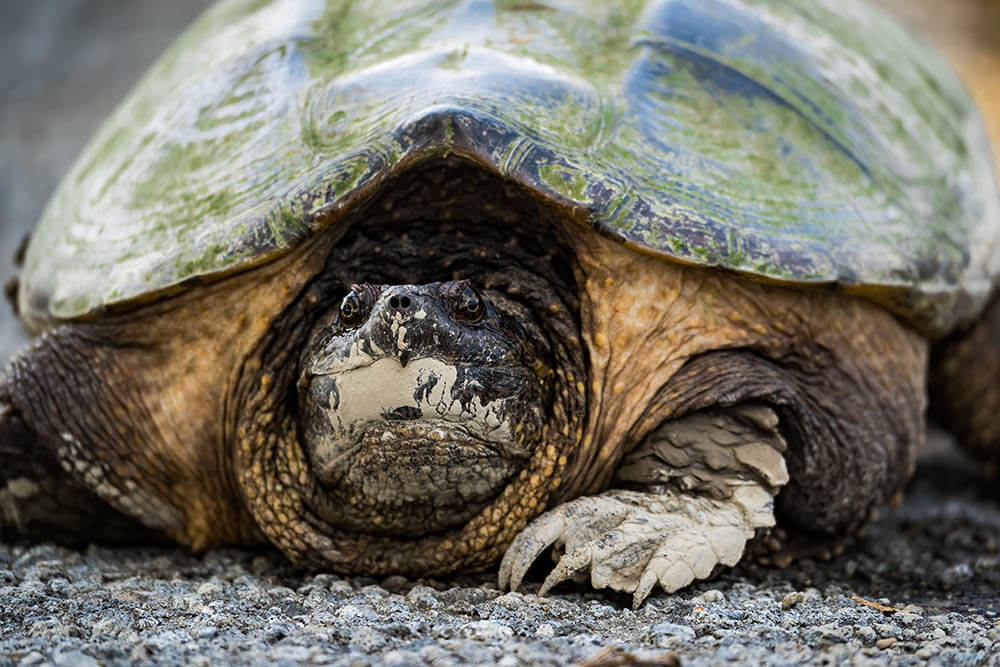
5. They require a special diet
The snapping turtle’s diet consists of not only plants but also animals. And it usually prefers its meat alive and kicking.
Feed your reptile live creepy crawlies (e.g. earthworms, crickets, roaches), fish (e.g. guppies, minnows), shrimp, and newborn rodents. You can even populate your pet’s pond with a small number of fish so that it can snack on these any time it likes.
You can also give it frozen-thawed rodents, chicks, and ducklings as occasional treats. If the idea of feeding a pet live bugs and fish or dead baby animals, then a snapper is the wrong pet for you.
In addition, you should provide your exotic pet with vegetables such as leafy greens around once a week. Fruits such as grapes and strawberries will also do. For your convenience, exotic pet stores sell snapping turtle food.
You need to feed baby snappers several times daily. A snapper that’s five months young or younger has to be fed every two days. Once fully grown, this creature only eats twice per week.
6. They’re not cuddly
You better think twice before hugging a snapping turtle or putting it on your lap. Don’t even consider sleeping next to it in bed.
Remember what we said earlier about these creatures avoiding interacting with others? Don’t take it personally; snappers simply evolved to be solitary, so forcing it to be anything but is unnatural and therefore threatening to it. Snuggle with a snapping turtle at your own risk!
While a snapping turtle will approach you whenever you bring it food, don’t expect it to show you any affection the way a dog or cat would. It’s not going ask for pets and it’s not going show you its belly in anticipation of belly rubs; these reptiles aren’t into any of that.
Not to mention it’s difficult to tell if a snapper can even feel any affection toward you. True, reptiles do feel and even express basic emotions such as fear and aggression, but whether or not they can feel love for their human owners is still largely a mystery. So again, don’t expect your exotic critter to develop a deep, lasting bond with you the same way a dog or cat will.

7. They may suffer from a range of health issues
Captive snapping turtles may suffer several illnesses thanks to inappropriate breeding and care. Such problems can reduce a turtle’s quality of life and even affect its life expectancy, shortening the 50 or more years it can enjoy if healthy.
The worrying thing is that the symptoms of these concerns typically don’t emerge until said concerns are already serious. For this reason, it’s vital you take excellent care of your pet and have a veterinarian check up on it regularly.
Some of the health issues snappers in captivity generally experience include:
- Obesity
- Ear abscesses
- Respiratory infected
- Internal parasites
- Vitamin A deficiency
- Egg retention
- Metabolic bone disease a.k.a. MBD
Unusual behavioral and physical changes such as the following are usually signs something is wrong with your pet:
- Loss of appetite
- Lethargy
- General weakness in the legs
- Gasping
- Weight loss
- Runny and stinky defecation
- Difficulty defecating
- Stinky pus-like ear discharge
- Cloudy eyes
- Pale shell
Contact an experienced snapping turtle veterinarian the moment you observe any of these symptoms. The sooner you act, the greater the likelihood of a successful recovery for your pet.
8. They can’t be tamed
Snapping turtles are wild animals. This means that, unlike domestic dogs and cats, they remain subject to their primal urges.
While a dog will refrain from hurting you even when they’re furious at you, an aggravated snapper won’t hesitate to sink its beak into you. Like it or not, this turtle will never feel completely comfortable around you no matter how much food you give it or affection you shower it with.
Also, keep in mind that training turtles, while possible, is exceedingly difficult, and there’s no guarantee it’ll obey you every time you issue a command. Even if you do manage to train one, it can only do the simplest of tricks. So don’t be too disappointed if you can’t housetrain your exotic pet; snappers like to poop and pee wherever and whenever they want!
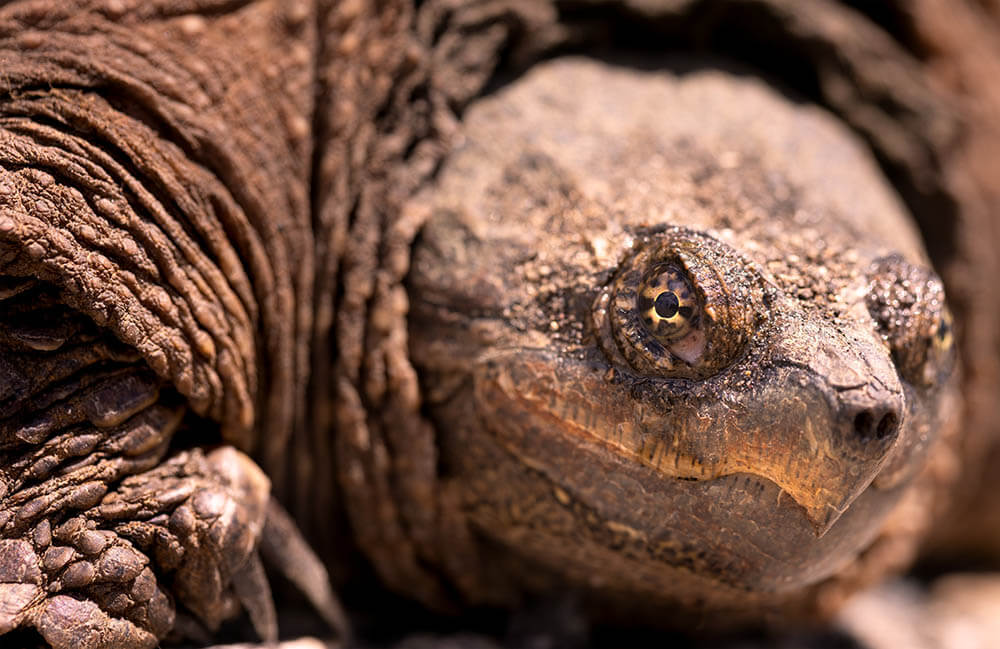
The Legality of Owning Pet Snapping Turtles
In the U.S., the following states prohibit the keeping of pet snappers:
- Arizona
- Arkansas
- Kansas
- Kentucky
- Nevada
- Rhode Island
In most states, it’s illegal to take a wild snapping turtle from its natural habitat to be kept as a pet. Therefore, if you want to own such a pet, purchase one from a reputable breeder who breeds these creatures in captivity. Baby snappers typically cost around $75, while adults will have you shelling out $150 or more.
Keep in mind, however, that in many states where snapper ownership is legal, you’ll be required to produce a permit or special documentation before being allowed to own an exotic pet.
Fun and Quick Snapping Turtle Facts
It’s time to expand our knowledge of snapping turtles!
- The common snapping turtle bite force (209 Newtons) isn’t as strong as the bite force we humans are capable of when biting down with our molars (up to 1300 Newtons).
- Because snapping turtles are larger than regular turtles, they can’t completely retreat into their shell to keep themselves safe from predators. They make up for this deficiency with the ability to snap at their enemies.
- Common snapping turtles generally live from 30 to 50 years. Alligator snapping turtles can have a lifespan lasting 11 to 45 years.
- When it comes to physical appearance, there are many differences between common snappers and alligator snappers. For instance, the former has a smoother shell whereas the latter has a shell with three prominent ridges. Common snappers also boast an oval-shaped head whereas alligator snappers have a triangular head.
- Common snappers typically weigh about 16 kilograms and have a shell measuring 25 to 50 centimeters long. Alligator snappers can weigh more than 100 kilograms and boast a shell up to 80 centimeters.
- The alligator snapper has a red tongue that looks like a worm, which it uses to lure fish into its mouth!
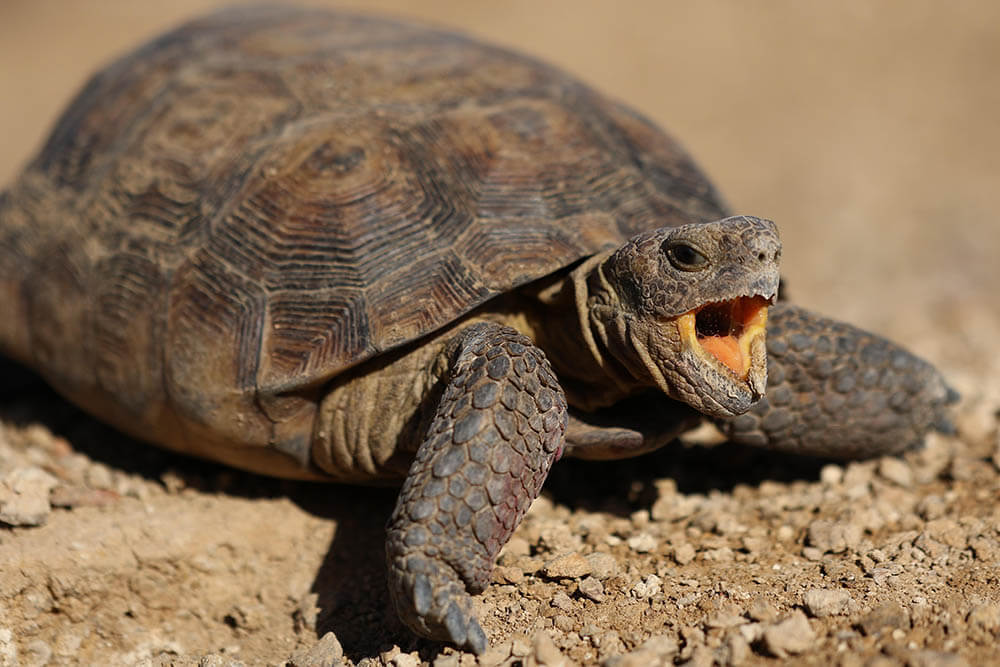
Conclusion
Snapping turtles make challenging, dangerous pets. They’re undomesticated, untamable animals capable of slicing off fingers with their powerful bite. They require a special enclosure and diet. You can’t hug them, and keeping them in captivity can leave them susceptible to myriad illnesses and diseases. And if you disturb them or show them cruelty, they can become vicious.
Nevertheless, for the most dedicated exotic pet owner, the prehistoric allure of these creatures can make them fascinating and rewarding pets. If you’d like to own one, make sure you’re well-experienced handling similarly difficult creatures, and don’t hesitate to seek help from experts whenever necessary.
